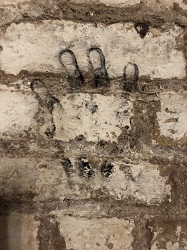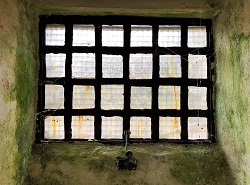It is at this time of the year, as Samhain approaches, the spirits of the dead were (and indeed are in some cases) welcomed into homes and many people turn their thoughts to the macabre. But not me. I’m preoccupied with misery year-round. For more than a decade I’ve been researching and writing about murder, punishment and incarceration. I’m currently writing a book about the Irish obsession with suffering and death – a book which has grown out of my research on dark tourism.
In 1996 John Lennon & Malcolm Foley defined dark tourism as ‘the phenomenon which encompasses the presentation and consumption (by visitors) of real and commodified death and disaster sites’. Essentially, it’s tourism closely associated with death, suffering and the macabre, and Ireland, with its myriad of sites associated with incarceration, emigration and famine has plenty of that on offer for visitors.
Early studies of dark tourism tended to focus on sites associated with the holocaust – particularly concentration camps. But this is a rapidly expanding field of research and in recent years academics have written about prison islands such as Alcatraz and Robben Island. Considerable attention has also been paid to Ground Zero in New York and the Peace Memorial Museum in Hiroshima amongst others. However, few historians have engaged with dark tourism and very little has been written about dark tourism in Ireland. That’s not because there isn’t any, far from it. When I began to research dark tourism I drew up a list of half a dozen sites, but as I travelled around the country I began to discover many more. Currently there are over seventy sites on my list, scattered through almost every county in Ireland. In some ways this is no surprise. From birth the Irish are buried alive in a never-ending avalanche of stories, ballads, plays, wakes, dirges, poems, paintings, ceremonies, museums and heritage sites that celebrate the macabre. From the tribulations of Peig Sayers to the plays of Samuel Beckett, we are reared on tales of suffering, oppression, misery, failed rebellions, famine, civil wars and emigration. As I toured the country examining how museums and heritage sites narrate Ireland’s difficult and often tragic past I am also looking at the landscape of loss and how the countryside bears the scars of much of the county’s dark history.
Academic study of dark tourism may be a relatively new phenomenon but people have been visiting sites associated with death, suffering, incarceration and execution for their entertainment for centuries. In the eighteenth and nineteenth centuries public executions were often regarded as popular entertainment while Dartmoor Prison has been attracting curious visitors since the late-nineteenth-century, so much so that in the 1930s the voyeurs gathered outside the walls were banned from taking photographs of the prisoners. In Ireland, people have been visiting the vaults in St Michan’s Church in Dublin to take a look at the mummified bodies since the early nineteenth century. This sort of tourism has always been controversial. In 1847, at the height of the famine, Alexis Soyer (a chef at the Reform Club in London) set up a ‘model’ soup kitchen in Dublin. Up to 5,000 people were fed a day, but the kitchen was also a spectacle and the elite of Dublin could pay to watch. The Freeman’s Journal was outraged and compared it to paying to watch feeding time at the Zoo.



Published: 30 Oct 2018 Categories: Cultural Studies, History, Visual and Material Culture

